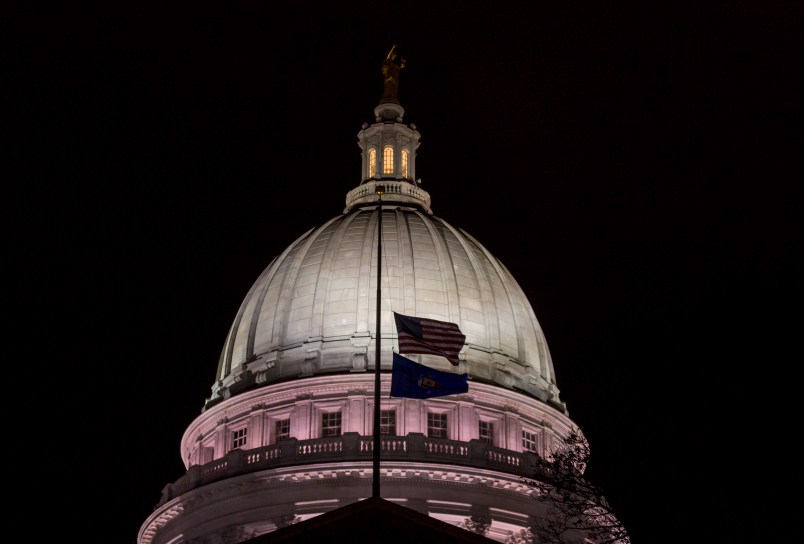Stay-at-home measures hastily slapped up by Wisconsin county governments are already falling apart less than a week after the state Supreme Court struck down Gov. Tony Evers’ (D) order and left the state in sudden free fall.
And since Republicans on both the Court and in the legislature have rendered Evers’ administration powerless in issuing any new statewide mandate, there is little left to stop the state’s inexorable roll towards full and unlimited reopening.
After issuing a slew of frantic orders to try to maintain some degree of shutdown in their counties, officials have been forced to repeal their mandates due to legal concerns and logistical infeasibility.
Brown County, home to Green Bay and site of the state’s largest per-capita COVID-19 outbreak, retracted its stay-at-home order on the advice of legal counsel.
“Based on research conducted during the last 24 hours, and on consultations with outside legal counsel, Brown County Corporation Counsel is now of the opinion that the legal basis for the order is likely not strong enough to withstand legal challenge,” wrote public health officer Anna Destree as she rescinded her stay-at-home order.
Brown County isn’t alone in its concern about the legality of local stay-at-home orders. The day the state Supreme Court struck down Evers’ order, the Wisconsin Counties Association aired its confusion on its website.
Noting that the power to enforce local orders comes from the same statute that the court declared “problematic” while nullifying Evers’ statewide one, the Association wrote that “it is unclear whether a local health order would, in the Court’s view, suffer from the same deficiencies that caused the Court to invalidate the Safer at Home Order.”
State Attorney General Josh Kaul issued an interim opinion last week asserting that local mandates remain untouched by the Court’s ruling.
“Because the court decision addressed a different statute applicable to a state agency, and not the statute applicable to local authorities, the Palm decision is not directly controlling on powers under the latter statute,” he said.
But many counties are unwilling to take the chance. Like Brown, Kenosha County, another of the most hard-hit areas of Wisconsin, also rescinded its stay-at-home order.
“With varying guidance from the Wisconsin Counties Association and more time to review best practices moving forward, together we’ve determined that we will withdraw our order and instead view Safer-at-Home as a series of best practices, rather than requirements,” Kenosha County corporation counsel Joseph Cardamone said in a statement.
Apart from the legal gray area, some counties threw in the towel after their neighboring counties did, realizing the logistical impossibility of maintaining different degrees of shutdown across such close geographic proximity.
“Part of the rationale for imposing a similar order in Manitowoc County was due to the potential of transmission of COVID-19 to County residents from the bordering Brown County, which has the highest incidence rate in the state,” wrote Manitowoc County Health Officer Mary Halada while reversing the county’s shutdown. But after Brown repealed its shutdown order, she continued, “that rationale no longer applies.”
And some, who hoped a temporary order could have bridged the gap until Evers and the Republican-majority legislature worked out an emergency rule, realized that their optimism was baseless.
“After conferring with the governor, it became clear that the legislature has no plans for a staged and sensible reopening of our public spaces,” said Outagamie County Executive Tom Nelson as he abandoned the county’s stay-at-home efforts.
On Monday, Evers told reporters on a conference call that he was withdrawing his outline for a statewide emergency rule when it became clear that Republicans wouldn’t play ball.
“I’m not saying this is an end of conversations,” he said. “But as it relates to the rule-making process, it’s not worth our time. We already know where they stand, and they control that process.”
State Sen. Steve Nass (R), co-chair of the Joint Committee on Review of Administrative Rules, had issued a blistering statement rejecting Evers’ plan out of hand.
Saying that while “most rational public servants” would have gotten the message from the Supreme Court’s ruling, Nass claimed that Evers’ administration was just attempting to take a new route to issue a statewide stay-at-home order.
Still, despite the many and growing forces against them, a few spots in Wisconsin are fighting to keep their communities shut down.
Dane County, home to Madison, issued a gradual reopening plan on Monday. Sarah Mattes, spokeswoman for the public health department, told TPM that “given our local data, we do not feel comfortable moving forward without a local order in place to prevent the spread of illness.”
Tom Barrett, mayor of Milwaukee, maintained the city’s lockdown even as nearby communities in the county opted to reopen.
“We still have hundreds of people that are dying, thousands of people who are sick, and the fact that there was a 4-3 decision by the state Supreme Court does not change, did not end the pandemic,” Barrett told local ABC affiliate WISN. “I’m not naive enough to think that there are no politics here, but I’m still very concerned about the spikes that could occur.”



